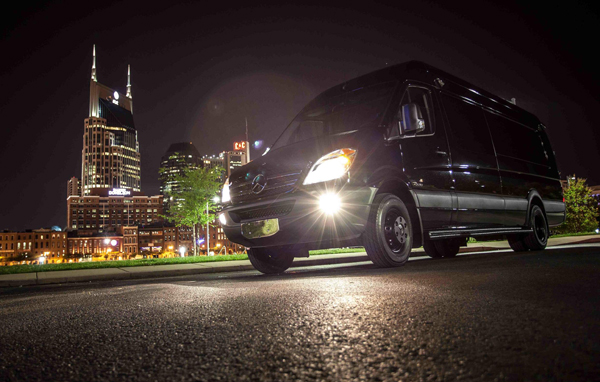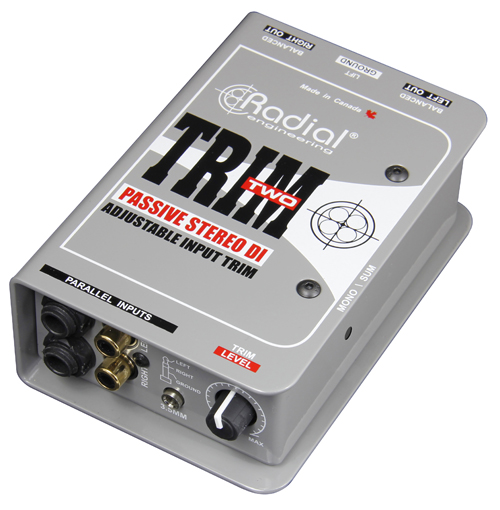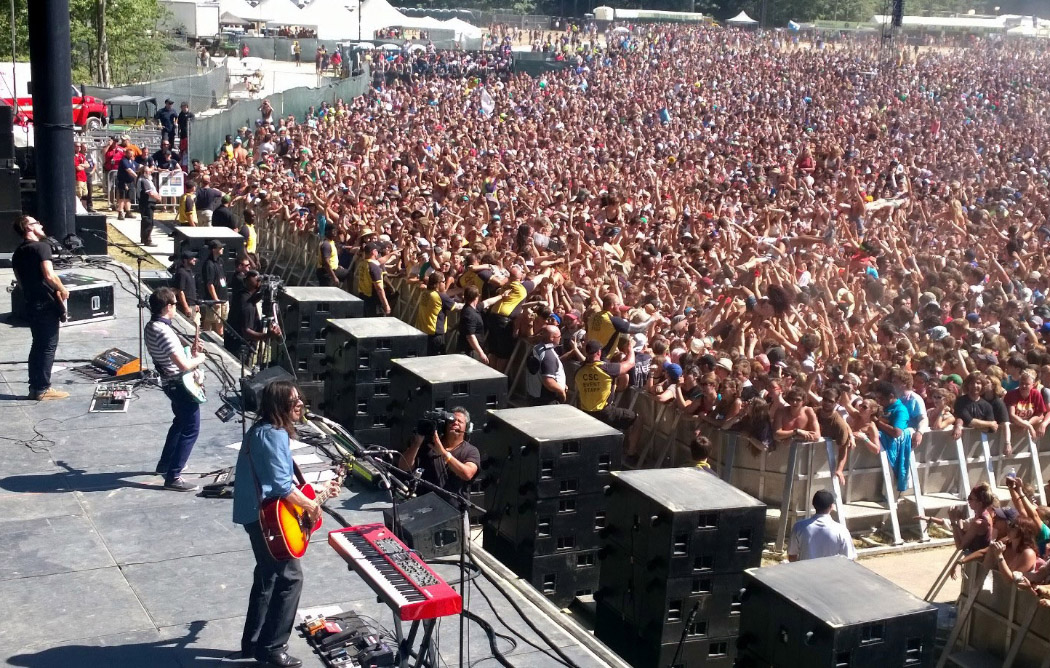Sharing is the very definition of a multi-act music festival, though some shares are bigger than others. Various performing artists or groups take turns with a venue’s audience and stage, as well as its sound, lights and video production.
Multi-act festivals provide more entertainment than the usual concert headliner with one or two support acts, using two or more festival stages to ensure continuous live music.
A festival’s added draw allows headliners to perform before larger crowds and openers to play for audiences that otherwise might never hear them. And each group saves the expense of mounting the entire production themselves, making these events a great way to get lots of exposure without spending a lot.
Some bands choose to spend an entire season in “festival mode,” filling in their schedules between festivals and state fair appearances with dates in full-production clubs and theaters.
Planes, Buses, Trailers…
The amount of equipment carried by a festival band and its crew ranges from headphones and a few guitars all the way up to headliners carrying several semi trailers with contributions from every department – backline, sound, lights, video, rigging, pyro, risers and a thrust – to add to the production du jour.
Between these extremes are buses hauling trailers of various sizes that include little more than backline, consoles and t-shirts, though “floor packages” of lights or video walls are increasingly common in larger double-axle condo trailers.

While a tour bus can carry up to 12 people and pull a trailer, a Sprinter van is less than half the cost, at the expense of carrying half as many people and less equipment, depending on how it’s fitted out with seats, bunks or cargo space. The Sprinter’s rear compartment is often walled off to create a space that’s five feet tall and wide by three to five feet deep, enough room for a modest backline and a console.
“Fly-in” shows are characterized by groups that tour primarily by air, allowing them to travel long distances between shows and sleep in the comfort of hotel rooms by carrying very little equipment. The grind of commercial flights often dictates that performers favor later flights or pre-show naps in their hotel rooms over sound checks, so the start of each show is often nerve-wracking for the first song. It’s said that you can never really cancel sound check, only postpone it.
Sound Check Alternatives
Bands can ease the nerves of “throw-and-go” by incorporating a “festival sound check” song into the top of their set lists, borrowed from the old days of analog consoles at festivals. Joe Cocker MD Mitch Chakour introduced this concept at The Sunderland Rusty Nail decades ago, explaining there wouldn’t be a sound check prior to doors, but the first set would begin with a song that started with kick, then hi-hat, then snare drum, adding in one at a time tom fills, electric bass, rhythm guitar, keyboards, and finally vocals. By the end of the song everything is settled at front of house, while the monitor engineer gets his tweaks in on stage.
While this approach may be too drastic for some, starting with the same song every day regardless of how the rest of the set is reorganized daily makes the beginning of each show comforting to band and crew alike. And if by chance there is a sound check, the best way to end it is always with that same song that starts the set.
Without carrying a mixing board, “file-based” tours rely on the audio equipment supplier to provide specific consoles to match not just their preferences, but that are compatible with a file from a previous show, along with the exact makes and models of microphones and DIs used to create the file.
Stock mic choices found in standard house or vendor inventory have the additional benefit of being able to be walked away from after the show, saving precious minutes on hectic itineraries. Note: the band’s engineers should carry any unusual mics that are important to the show’s sound.
Handling Tracks
Some bands use “sweetening” tracks to add the sound of additional musicians that aren’t practical to bring on tour. Since tracks aren’t often featured musicians, they usually break down into 1) percussion; 2) keys, strings or horn “pads;” and 3) background vocals (BGVs).
If you have all three, they’re likely in stereo, plus a click track and perhaps a mono “ahem” lead vocal guide track, for a total of eight tracks, useful with an eight-output laptop interface, typically 1RU. Big acts run a redundant set-up with dual computers and a switchover, such as an SW8 from Radial Engineering. This rig fills a Pelican case, eight more DIs must be supplied, and eight more channels are needed in the input list.
An alternative for clubs and festivals is to mix all the tracks to mono, put click track on the other channel of a stereo track, and use an iPhone or iPad for solid-state playback, routing tracks to FOH and click to the drummer. Radial Engineering’s passive Trim-Two DI provides a volume control for the playback operator (drummer) to make adjustments, otherwise a pair of passive DIs works OK. Balancing tracks to a mono mix can be a challenge, but carrying tracks in a pocket is a blessing, and they can be plugged into any pair of stereo keyboard inputs on a festival stage.

In order for the festival’s audio crew to provide what’s needed for the band, a one-page document that combines an input list with a stage plot is essential. File-based tours require that not only the input list be in the correct order, but that each input has the correct channel number, so the file lines up with the physical inputs.
Online search the words “stage plot input list” and plenty of examples can be found. I’ve used MS Word to create input lists and plots for years, but so many bands use StagePlot Pro’s application that it’s unusual to see anything else at festivals, unless it’s the Sharpie/cocktail napkin variety.
Since sub-snakes usually come in 12 channels, a festival drum patch that tries to accommodate any kit normally takes all 12. Planning input lists, it may seen like a good idea to use as few mics and DIs as possible. Many drum kits only need eight mics and the entire group may only need 16 inputs, but on festival stages there may only be moments to troubleshoot last-minute problems.
Using two inputs for kick, snare, bass, keys and even on guitar rigs allows more creative choices in the mix as well as providing backup, besides helping monitor engineers use instruments with dual inputs differently for different performers and to create better stereo mixes. It’s easy to see how planning for a 24-channel list still doesn’t leave enough room for extras.
With the advent of 96 kHz MADI, 32 channels is becoming a new standard for live sound, instead of 48. Club engineers that started on Yamaha LS9 or Behringer X32 consoles and/or the plethora of previous 32-channel analog desks are used to 32-channel lists. A dozen drum mics and a dozen more backline and vocal inputs leaves a half dozen spare channels and two more for console talkback.
Spare Channels
In a 32-channel footprint, putting drums in the first dozen inputs and leaving four channels unused allows instruments to start in channel 17, followed by vocals.
When creating an input list, it’s better to have a few inputs that are rarely used than to have something crop up and have nowhere to plug it in. If a horn section was used on the album for even a few songs, adding horns for special shows can be expected.
The same applies for supplemental acoustic instruments even if it’s just for a couple of songs, a ballad or a breakdown section in the middle of the show. Inputs for cajon, upright bass, fiddle, dobro or steel and acoustic guitar, even if not used regularly, would help longer sets and can simply be alternates for horn inputs. A third, more likely use for spare inputs on the festival circuit is to make it easy for a guest musician to sit in, even if the information isn’t forthcoming until the last minute.
With only support or festival appearances, extra channels aren’t needed for horn or breakdown inputs, but the band is likely to meet or make friends and want them to sit in. A block of “guest” channels should include a spare vocal and active DI downstage, plus an extra guitar amp mic and a fourth channel for a spare wireless or keyboard DI upstage.
The Middle
Somewhere between headliners and fly-ins are numerous bands or groups in buses or vans with trailers. The hybrid approach to festival and file-based touring is to travel with a small digital console that serves as the band’s monitor and perhaps rehearsal console. A festival splitter sends inputs to the FOH console’s stagebox and split to the small monitor console carried by the band, which can send outputs to house wedge amplifiers and/or in-ear monitoring (IEM) systems.
In smaller venues, a band’s monitor console can also be used to generate a house mix by patching Left, Right and Sub aux sends into the house snake, using only three house channels and eliminating running a separate snake. This is helped by using an iPad for remote control, but beware of trying to use 2.4 GHz Wi-Fi when most of the audience has smartphones.
Remote control iPad apps allow engineers freedom to move around the venue or stage to make adjustments and performers can similarly adjust their own monitor mix from their iPhone. Since 2010, most tablets and smart phones have 802.11n Wi-Fi that can operate at 5 GHz, where there’s more capacity and less interference than 2.4 GHz.
On most Wi-Fi routers, older 802.11 “b” and “g” protocols can be turned off, allowing response only to newer “n” Wi-Fi. Further, the router’s SSID broadcast can be turned off, so it won’t appear in other devices’ site surveys. Its SSID must then be manually entered using “Other…” under “CHOSE A NETWORK.”
I prefer SSID names like “AndroidVirus” and use my phone number as a WPA2 Pre-Shared Key password that’s easy to remember. Performing these tasks at a show can add to the day’s stress, especially if more than one member of the band or crew is trying to control the console. Writing the SSID and password on the bottom of the router is recommended, especially if you turn off its SSID.















